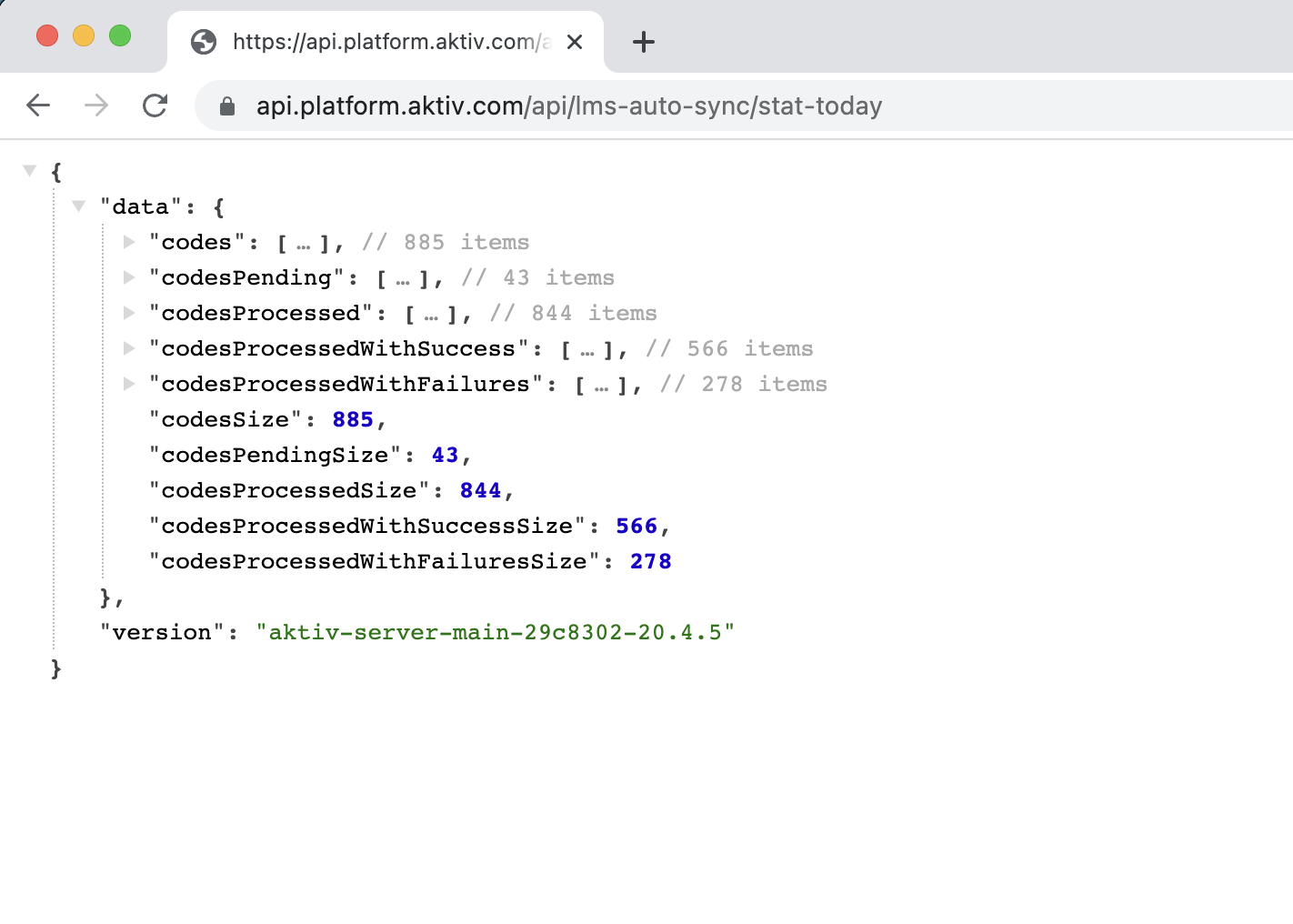Aktiv Learning

Home > Guides > LMS Auto Sync (QA)
Use the following guides to QA LMS Auto Sync.
LMS Auto Sync QA Guide
-
API: Check the current LMS Auto Sync Stats (for today).
- Use the APIs below to get a result of the processed course codes stats.
-
Click on the link below, which will open it up in your browser (such as Chrome):
- You will get results that look like this:
-
If yours doesn’t look this pretty it means you should install a JSON formatter extension for your browser. Install this Json Formatter for Chrome.
codes: This is a list of all possible course codes that should be LMS auto synced today.codesPending: This is a list of course codes that are still waiting to be LMS auto synced today.codesProcessed: This is a list of course codes that have already been auto synced today.codesProcessedWithSuccess: This is a list of course codes that have already been auto synced today that achieved 100% success (i.e. no student sync failed).codesProcessedWithFailures: This is a list of course codes that have already been auto synced today BUT had at least 1 failure (i.e. at least 1 student sync failed).
And here are the “count” of each of the previous fields:
codesSize: The count ascodesabove.codesPendingSize: The count ascodesPendingabove.codesProcessedSize: The count ascodesProcessedabove.codesProcessedWithSuccessSize: The count ascodesProcessedWithSuccessabove.codesProcessedWithFailuresSize: The count ascodesProcessedWithFailuresabove.
-
API: Check the queue.
-
Use the APIs below to get a result of the current queue { remaining:300, limit: 1000 } which means that 300 are left to process out of the possible 1000.
-
-
The LMS auto syncer only syncs courses that are in a “current” or “previous” term. See next sections for definitions.
-
“Current” course term is defined as any seasonal term or academic yearly term that is within date range. A term is either a seasonal term such as
WINTER_2023, or is an academic yearly term such asACADAMIC_YEAR_2022_2023. Each term has a start date and end date based on customer success team definitions.WINTERandSPRINGgo from 1st of Jan to 30th of April.SUMMERandFALLgo from 1st of May to 31st of December.ACADEMIC_YEAR_Xgo from 1st of May to 30th of April (the following year).
Examples:
- So for e.g.
WINTER_2021goes from 1st of Jan 2021, to 30th of April 2021. - So for e.g.
SPRING_2021goes from 1st of Jan 2021, to 30th of April 2021. - So for e.g.
SUMMER_2021goes from 1st of May 2021, to 31st of December 2021. - So for e.g.
FALL_2021goes from 1st of May 2021, to 31st of December 2021. - So for e.g.
ACADEMIC_YEAR_2021_2022goes from 1st of May 2021, to 30th of April 2022. - So for e.g.
ACADEMIC_YEAR_2022_2023goes from 1st of May 2022, to 30th of April 2023.
“Current” Examples:
- So for e.g. if today is 2021-05-01 then
SUMMER_2021,FALL_2021andACADEMIC_YEAR_2021_2022is current. - So for e.g. if today is 2021-04-30, then
WINTER_2021,SPRING_2021andACADEMIC_YEAR_2020_2021is current.
-
“Previous” course term is defined as any term that is before a “Current” term.
- For e.g. 2023-04-30 returns:
SUMMER_2022FALL_2022WINTER_2023SPRING_2023ACADEMIC_YEAR_2021_2022ACADEMIC_YEAR_2022_2023
- For e.g. 2023-05-01 returns:
WINTER_2023SPRING_2023SUMMER_2023FALL_2023ACADEMIC_YEAR_2022_2023ACADEMIC_YEAR_2023_2024
- For e.g. 2023-04-30 returns:
